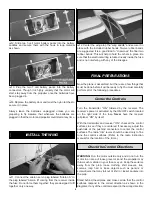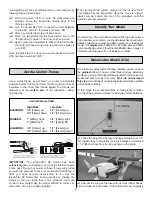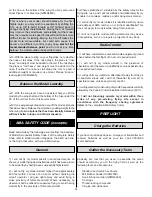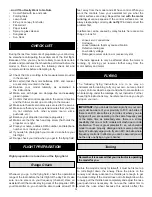
rudder. Note: Crosswinds may affect the direction the model
rolls, so this test should be done in calm conditions, or with
the model facing directly into the wind.
If possible, takeoff directly into the wind. If you are
experienced, taking off in a crosswind is permissible (and
sometimes necessary–depending upon the prevailing wind
conditions and runway heading). Taking off into the wind will
help the model roll on a straight path and also reduces
ground speed for takeoff. Taxi the model onto the runway or
have an assistant carry it out and set it down pointing into
the wind down the runway. When ready, gradually advance
the throttle while simultaneously using the left stick
(rudder/nose wheel) to steer the model. Gain as much
speed as the runway and flying site will practically allow
before gently applying up elevator, lifting the model in the air.
A good method to remember is to apply slight pressure to
the sticks rather than pushing or pulling on them. Be ready
to make immediate corrections with the ailerons to keep the
wings level and be smooth on the elevator stick, allowing the
model to establish a gentle climb to a safe altitude before
making the first turn (away from yourself).
Once airborne, maintain a steady climb and make the initial
turn away from the runway. When at a comfortable, safe
altitude, throttle back to slow the model. This will give you more
time to think and react. The ElectriStar EP Select should fly
well at half or slightly less than half-throttle. Adjust the trims so
that the plane flies straight and level. After flying around for
awhile still at a safe altitude with plenty of battery power,
practice slow flight and execute practice landing approaches
by reducing the throttle further to see how the model handles
when coming in to land. Add power to see how the model
climbs as well. Continue to fly around while learning how the
model responds. Mind your battery power level, but use the
first flight to become familiar with the model before landing.
With electric planes it’s best to land with some battery power
remaining. This will allow you to abort the landing and go
around again if needed. To initiate a landing approach, lower
the throttle while on the downwind leg. Allow the nose of the
model to pitch downward to gradually bleed off altitude.
Continue to lose altitude, but maintain airspeed by keeping
the nose down as you turn onto the crosswind leg. Make
your final turn toward the runway (into the wind), keeping the
nose down to maintain airspeed and control. Level the
attitude when the model reaches the landing area,
modulating the throttle as necessary to maintain your glide
path and airspeed. If you are going to overshoot, smoothly
advance the throttle (always ready on the right rudder to
counteract torque) and climb out to make another attempt.
When you are ready to make your landing flare and the
model is a foot or so above the ground, smoothly increase
up elevator until it gently touches down.
After you have landed and shut the motor down, adjust the
pushrods on the ailerons, elevator, and rudder as necessary
so the trim levers on the transmitter can be returned to
center (this will not be required on any of the channels that
did not need trim adjustments).
After your flight, the motor batteries will be hot. Allow them
to cool down before attempting to re-charge them.
Good luck and remember to have fun!
Make a copy of this identification tag and put it on or
inside your model.
ElectriFly
™
7-Cell, 8.4V 3600mAh NiMH Battery Pack
The sub-C NiMH cells in this flat pack are affordably priced
and deliver incredible power. High-capacity cells mean
extended flight time and less frequent charging. Each pack
features a Deans
®
Female Ultra
™
connector on 4" long,
12AWG flexible silicone-insulated wire, along with heavy-
duty silver battery bars. Perfect for large electric models
where weight is not critical, or for converting glow-powered
planes to electric power. GPMP0361
ALSO AVAILABLE FROM HOBBICO
If you are performing practice landings, it is best to practice
these during the first 6 minutes of flying.
Landing
Flight
Takeoff
14
















